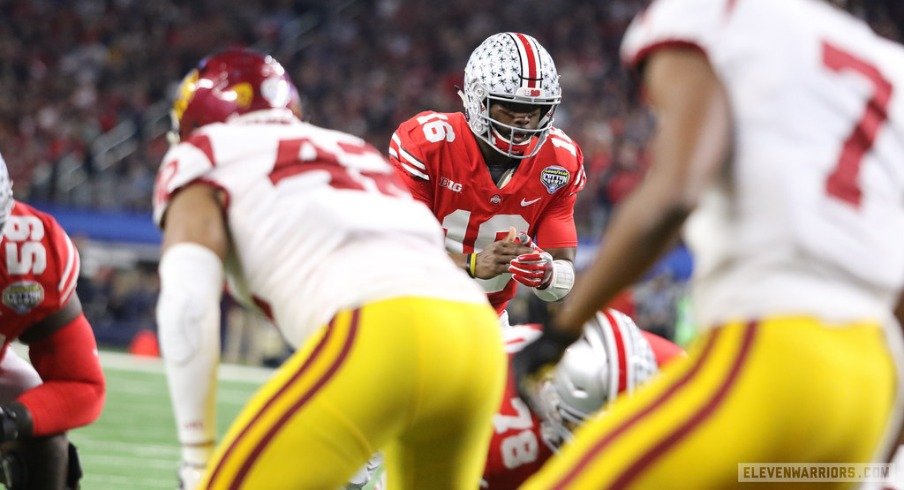Things are about to change in the Big Ten.
Thursday’s announcement that USC and UCLA are set to leave the Pac-12 and join Ohio State and company in 2024 was a bombshell in the world of collegiate athletics, and is certain to have ripple effects across the college football landscape in the months – and years – to come.
Other conferences will surely make attempts to realign in response to the move from the Big Ten, and the Big Ten itself may not be done adding to its list of member institutions in the near future if speculation is to be believed. But as of now, all we know for certain is that USC and UCLA are just a couple years out from becoming new adversaries for all other Big Ten programs.
The impact on Ohio State in particular will be considerable for a multitude of reasons, and we've delved into a number of them below.
Another Blue-Blood Competitor
Ohio State has largely dominated the Big Ten over the past decade, winning four of the past five conference championships and five of the past eight. But with USC joining the fold, the Buckeyes will have another fierce competitor in the annual race for the conference crown.
Sure, USC has only played in one bowl game in the past four years, but Lincoln Riley’s arrival in Southern California is expected to breathe new life into the lungs of the sleeping giant. Riley’s high-flying offenses in Oklahoma produced numerous Heisman Trophy winners and four College Football Playoff appearances, and there’s little doubt that will soon become the expectation for the Trojan program under his leadership.
Excited to be a part of this historic move-
— Lincoln Riley (@LincolnRiley) July 1, 2022
Cant wait-
Fight On! https://t.co/4hu2z1BuvV
Although USC hasn’t won a national title since 2004, it claims nine in its storied history, which also includes 39 conference championships, 55 bowl appearances and six Heisman Trophy winners. The recruiting cache Riley brings to the table has already been felt in Los Angeles, which means USC could quickly be back on its once great trajectory moving forward.
Head-to-head, USC is 13-10-1 against the Buckeyes all-time, but claimed seven straight wins over Ohio State from 1975 to 2009 before losing to the scarlet and gray in the 2017 Cotton Bowl.
With USC in the mix, the Buckeyes will have another major threat to contend with for Big Ten supremacy beyond the usual suspects like Michigan, Penn State and Wisconsin.
Bigger Budget Due to Big Ten TV Deal
The Big Ten brand will only get bigger with the addition of USC and UCLA, which will expand the conference’s reach from coast to coast. That could mean more money for all member institutions when the Big Ten restructures its TV deal in the near future.
According to a report from The Athletic’s Scott Dochternan on June 14, Big Ten commissioner Kevin Warren and a number of Fox executives recently heard final pitches from companies like ABC, CBS, NBC and Amazon for media rights packages. The Big Ten could potentially earn $1 billion annually from the new deal, per the report.
Mind you, that was before Thursday’s news regarding USC and UCLA.
The Big Ten's footprint now will consist of schools in five of the seven largest metro markets: 1. New York; 2. Los Angeles; 3. Chicago; 6. Washington D.C.; 7. Philadelphia.
— Scott Dochterman (@ScottDochterman) June 30, 2022
A monster deal for the new-look Big Ten will lead to increased profits for Ohio State and the rest of the programs in the conference, which will, in turn, lead to expanded budgets for the athletics departments in Columbus and beyond.
Not only is that a win for the Ohio State football team, but it will also open up the checkbook for the rest of the Buckeyes’ sports programs as well.
Big Ten Won't Be "Left Behind"
With the addition of Texas and Oklahoma to the SEC, which will expand the conference to 16 teams in 2025, discussions about a super league that could operate as its own entity in college football have not been hard to find.
The Big 12 was left in the wake of the move, and “the Alliance” between the Big Ten, Pac-12 and ACC was effectively a countermeasure by the rest of the Power 5 conferences to gain back power in the sport’s landscape. But the parameters of the partnership were vague from the start and the bond was short-lived as the Big Ten has now poached two of the Pac-12’s most notable member universities.
In pivoting to bring in USC and UCLA, the Big Ten made a power play that won’t allow it to be “left behind” by the mighty SEC, as some have feared. With control of multiple major markets for college football, the Big Ten will see its relevance rise, which is a bonus for Ohio State as one of the most recognizable brands in the sport.
More Trips to the Rose Bowl
Typically the Buckeyes have to punch their ticket to Pasadena with a Rose Bowl berth at the end of the season, and in the CFP era, that’s only if the chips fall a certain way for Ohio State.
Ohio State has played in the Rose Bowl just three times since 2009, and the Buckeyes weren’t all that thrilled to be there this past season since it meant they missed a chance to compete for college football’s biggest prize. But with UCLA soon to be in the Big Ten, those trips will be a lot more frequent and they won’t mean the Buckeyes are missing out on a better postseason path.
The Buckeyes may not play the Bruins every year, given the growing number of teams in the conference, but UCLA’s presence in the Big Ten should guarantee that Ohio State gets to play in perhaps college football’s most iconic setting more often than it would have otherwise.
Even if Ohio State isn’t playing in Pasadena, it will have more trips to Southern California in general, as the Buckeyes will also play plenty of games at the Los Angeles Memorial Coliseum when USC plays host to the scarlet and gray in the years to come.
Increased Recruiting Exposure in California
Ohio State has already enjoyed plenty of recruiting success in the state of California in recent years. Just ask C.J. Stroud and Chris Olave; two of the foremost standout performers in the program over the past several seasons who both hail from the Golden State.
With the Big Ten’s reach now expanding out west, though, Ohio State will only get more exposure in the recruiting hotbed that is California.
While Pac-12 fans might not typically have tuned into Big Ten matchups, college football fans in Southern California will quickly become indoctrinated into the conference when their favorite teams begin taking on teams from the newly restructured league. Of course, Ohio State is the largest brand of all Big Ten teams, and will soon be regularly seen in the Los Angeles market during the regular season in a way that it never was before.
Midseason trips to California may also help the Buckeye coaching staff get out to high school games to recruit local prospects, which is sure to aid Ohio State’s recruiting efforts in the state on top of the aforementioned factors.
Impact on Basketball, Olympic Sports
The Big Ten’s latest additions won’t just affect the Buckeye football program. While USC is the far more formidable foe on the gridiron, the Ohio State men’s basketball team will soon face two stellar programs on the hardwood with regularity as the Trojans and Bruins join the Big Ten.
The storied UCLA basketball program has 11 NCAA Tournament titles to its credit (although none since 1995), was a No. 4 seed in the Big Dance this past season and reached the Final Four in 2021.
USC doesn’t have quite the same historical pedigree in basketball, but the Trojan program has enjoyed success just the same in recent years. Under head coach Andy Enfield, USC has not suffered double-digit defeats in the past three seasons. The Trojans were a No. 7 seed in the NCAA Tournament this past year, and a No. 6 en route to a regional final berth the year before.
The cross-country travel required for frequent trips to California may seem like something of a concern for the Olympic sports that don’t receive the same financial resources as the football or men’s basketball teams. But as mentioned before, the money generated from the Big Ten’s restructured TV deal figures to help all parties as the athletics department adjusts to the new boundaries of the conference.


